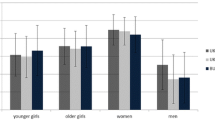Abstract
A study was conducted to test the hypothesis that inferences of homosexuality will be made more frequently about women who are perceived to be less physically attractive. This hypothesis was supported. More importantly, the investigation was designed to determine whether the perception of a relationship between female homosexuality and level of physical attractiveness would be affected by raters' attitudes about homosexuality and traditional sex-role behavior. Results indicated that female raters with conservative attitudes were likely to associate homosexuality with those women to whom they had given the worst evaluations concerning physical appearance, while more liberal females were less likely to do so. Male raters' attitudes bore little relationship to their evaluations of homosexuality and physical attractiveness. Several interpretations of these results are discussed.
Similar content being viewed by others
References
Banziger, G., & Hooker, L. The effects of attitudes toward feminism and perceived feminism on physical attractiveness ratings. Sex Roles, 1979, 5, 437–442.
de Monteflores, C., & Schultz, S. J. Coming out: Similarities and differences for lesbian and gay men. Journal of Social Issues, 1978, 34, 59–72.
Dion, K. K. Physical attractiveness and evaluation of children's transgressions. Journal of Personality and Social Psychology, 1972, 24, 207–213.
Dion, K. K., Berscheid, E., & Walster, E. What is beautiful is good. Journal of Personality and Social Psychology, 1972, 24, 285–290.
Fishbein, M. A consideration of beliefs and their role in attitude measurement. In M. Fishbein (Ed.), Readings in attitude theory and measurement. New York: John Wiley & Sons, 1967.
Gillen, B. Physical attractiveness: A determinant of two types of goodness. Personality and Social Psychology Bulletin, 1981, 7, 277–281.
Goldberg, P. A., Gottesdiener, M., & Abramson, P. R. Another put-down of women?: Perceived attractiveness as a function of support for the feminist movement. Journal of Personality and Social Psychology, 1975, 32, 113–115.
Goldstein, F. J. Sexual identity deviation and inversion. In G. H. Seward & R. C. Williamson (Eds.), Sex roles in changing society. New York: Random House, 1970.
Gurwitz, S. B., & Marcus, M. Effects of anticipated interaction, sex, and homosexual stereotypes on first impressions. Journal of Applied Social Psychology, 1978, 8, 47–56.
Harry, J., & DeVall, W. B. The social organization of gay males. New York: Praeger, 1978.
Hsu, E. H. An experimental study of rationalization. Journal of Abnormal and Social Psychology, 1949, 44, 277–278.
Jay, K., & Young, A. The gay report: Lesbians and gay men speak out about sexual experiences and lifestyles. New York: Summit Books, 1979.
Johnson, R. W. Perceived physical attractiveness of supporters of Canada's political parties: Stereotype or in-group bias? Canadian Journal of Behavioral Science, 1981, 13, 320–325.
Johnson, R. W., Doiron, D., Brooks, G., & Dickinson, J. Perceived attractiveness as a function of support for the feminist movement: Not necessarily a put-down of women. Canadian Journal of Behavioral Science, 1978, 10, 214–221.
Johnson, R. W., Holborn, S. W., & Turcotte, S. Perceived attractiveness as a function of active vs. passive support for the feminist movement. Personality and Social Psychology Bulletin, 1979, 5, 227–230.
Karlins, M., Coffman, T. L., & Walters, G. On the fading of social stereotypes: Studies in three generations of college students. Journal of Personality and Social Psychology, 1969, 13, 1–16.
Kitsuse, J. I. Societal reaction to deviant behavior: Problems of theory and method. Social Problems, 1962, 9, 247–256.
Korabik, K. Sex-role orientation and impressions: A comparison of differing genders and sex roles. Personality and Social Psychology Bulletin, 1982, 8, 25–30.
Landy, D., & Sigall, H. Beauty is talent: Task evaluation as a function of the performer's physical attractiveness. Journal of Personality and Social Psychology, 1974, 29, 299–304.
Maccoby, E. E., & Jacklin, C. G. The psychology of sex differences. Stanford, CA: Stanford University Press, 1974.
Nisbett, R. E., & Wilson, T. D. The halo effect: Evidence for unconscious alteration of judgments. Journal of Personality and Social Psychology, 1977, 35, 250–256.
Pursell, S. A., & Banikiotes, P. G. Androgyny and initial interpersonal attraction. Personality and Social Psychology Bulletin, 1978, 4, 235–239.
Riddle, D. I. Relating to children: Gays as role models. Journal of Social Issues, 1978, 34, 38–58.
Schoedel, J., Frederickson, W. A., & Knight, J. M. An extrapolation of the physical attractiveness and sex variables within the Byrne attraction paradigm. Memory and Cognition, 1975, 3, 527–530.
Scott, W. A., Osgood, D. W., & Peterson, C. Cognitive structure: Theory and measurement of individual differences. New York: John Wiley & Sons, 1979.
Snyder, M., Tanke, E., & Berscheid, E. Social perception and interpersonal behavior: On the self-fulfilling nature of social stereotypes. Journal of Personality and Social Psychology, 1977, 35, 656–666.
Unger, R. K., Hilderbrand, M., & Madar, T. Physical attractiveness and assumptions about social deviance: Some sex-by-sex comparisons. Personality and Social Psychology Bulletin, 1982, 8, 293–301.
Walster, E., Aronson, V., Abrahams, D., & Rottmann, L. Importance of physical attractiveness in dating behavior. Journal of Personality and Social Psychology, 1966, 4, 508–516.
Weitz, S. Sex roles. New York: Oxford University Press, 1977.
West, D. J. Homosexuality. Chicago: Aldine, 1968.
Author information
Authors and Affiliations
Additional information
These data were collected at the Johns Hopkins University and the results were presented at the annual meeting of the Eastern Psychological Association in Hartford, Connecticut, April 1980. I thank J. T. Becker, J. A. Hall, C. M. Judd, and R. Rosenthal for comments on the manuscript.
Rights and permissions
About this article
Cite this article
Dew, M.A. The effect of attitudes on inferences of homosexuality and perceived physical attractiveness in women. Sex Roles 12, 143–155 (1985). https://doi.org/10.1007/BF00288043
Issue Date:
DOI: https://doi.org/10.1007/BF00288043




